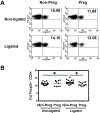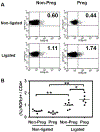Down-regulated Treg cells in exacerbated periodontal disease during pregnancy
- PMID: 30753969
- PMCID: PMC6411422
- DOI: 10.1016/j.intimp.2019.01.031
Down-regulated Treg cells in exacerbated periodontal disease during pregnancy
Abstract
Pregnancy is a special period marked with complicated changes in various immune responses. Although pregnant women are prone to developing gingival inflammation, its immunological mechanism remains to be clarified. In a modified ligature-induced periodontal disease murine model, pregnant mice developed more severe alveolar bone loss. Using this model, we investigated the Treg responses during exacerbated periodontal disease in pregnant mice. We tested Treg-associated molecules in gingival tissues by quantitative real-time PCR and found decreased gingival expression of Foxp3, TGFβ, CTLA-4, and CD28 in pregnant mice after periodontal disease induction. We further confirmed that lower number of Treg cells were present in the cervical lymph nodes of pregnant periodontitis mice. Treg cells from the cervical lymph nodes of ligated pregnant mice and non-pregnant mice were tested for their suppressive function in vitro. We manifested that Treg suppressive function was also down-regulated in the pregnant mice. Additionally, we demonstrated that more inflammatory Th17 cells were present in the cervical lymph nodes of ligated pregnant mice. Therefore, impaired Treg development and function, together with upregulated Th17 response, may contribute to the exacerbated periodontal disease during pregnancy.
Keywords: Alveolar bone loss; Periodontal disease; Porphyromonas gingivalis; Pregnancy; Th17; Treg.
Copyright © 2019 Elsevier B.V. All rights reserved.
Figures





Similar articles
-
Oral administration of all-trans retinoic acid suppresses experimental periodontitis by modulating the Th17/Treg imbalance.J Periodontol. 2014 May;85(5):740-50. doi: 10.1902/jop.2013.130132. Epub 2013 Aug 16. J Periodontol. 2014. PMID: 23952076
-
The Treg/Th17 imbalance in Toxoplasma gondii-infected pregnant mice.Am J Reprod Immunol. 2012 Feb;67(2):112-21. doi: 10.1111/j.1600-0897.2011.01065.x. Epub 2011 Sep 19. Am J Reprod Immunol. 2012. PMID: 21923716
-
Porphyromonas gingivalis induces exacerbated periodontal disease during pregnancy.Microb Pathog. 2018 Nov;124:145-151. doi: 10.1016/j.micpath.2018.08.019. Epub 2018 Aug 15. Microb Pathog. 2018. PMID: 30118804 Free PMC article.
-
Transcriptional and posttranslational regulation of Th17/Treg balance in health and disease.Eur J Immunol. 2021 Sep;51(9):2137-2150. doi: 10.1002/eji.202048794. Epub 2021 Aug 15. Eur J Immunol. 2021. PMID: 34322865 Review.
-
The presence, function and regulation of IL-17 and Th17 cells in periodontitis.J Clin Periodontol. 2014 Jun;41(6):541-9. doi: 10.1111/jcpe.12238. Epub 2014 Apr 15. J Clin Periodontol. 2014. PMID: 24735470 Review.
Cited by
-
Application of Ligature-Induced Periodontitis in Mice to Explore the Molecular Mechanism of Periodontal Disease.Int J Mol Sci. 2021 Aug 18;22(16):8900. doi: 10.3390/ijms22168900. Int J Mol Sci. 2021. PMID: 34445604 Free PMC article. Review.
-
Treg: A Promising Immunotherapeutic Target in Oral Diseases.Front Immunol. 2021 Jun 10;12:667862. doi: 10.3389/fimmu.2021.667862. eCollection 2021. Front Immunol. 2021. PMID: 34177907 Free PMC article. Review.
-
Targeting Th17 cells: a promising strategy to treat oral mucosal inflammatory diseases.Front Immunol. 2023 Jul 26;14:1236856. doi: 10.3389/fimmu.2023.1236856. eCollection 2023. Front Immunol. 2023. PMID: 37564654 Free PMC article. Review.
-
Injecting Immunosuppressive M2 Macrophages Alleviates the Symptoms of Periodontitis in Mice.Front Mol Biosci. 2020 Oct 23;7:603817. doi: 10.3389/fmolb.2020.603817. eCollection 2020. Front Mol Biosci. 2020. PMID: 33195441 Free PMC article.
-
Gut-Bone Axis: A Non-Negligible Contributor to Periodontitis.Front Cell Infect Microbiol. 2021 Nov 16;11:752708. doi: 10.3389/fcimb.2021.752708. eCollection 2021. Front Cell Infect Microbiol. 2021. PMID: 34869062 Free PMC article. Review.
References
-
- Carrillo-de-Albornoz A, Figuero E, Herrera D, and Bascones-Martinez A (2010). Gingival changes during pregnancy: II. Influence of hormonal variations on the subgingival biofilm. Journal of clinical periodontology 37, 230–240. - PubMed
-
- Arafat AH (1974). Periodontal status during pregnancy. Journal of periodontology 45, 641–643. - PubMed
-
- Loe H, and Silness J (1963). Periodontal Disease in Pregnancy. I. Prevalence and Severity. Acta odontologica Scandinavica 21, 533–551. - PubMed
-
- Cohen DW, Shapiro J, Friedman L, Kyle GC, and Franklin S (1971). A longitudinal investigation of the periodontal changes during pregnancy and fifteen months post-partum. II. Journal of periodontology 42, 653–657. - PubMed
-
- Raber-Durlacher JE, van Steenbergen TJ, Van der Velden U, de Graaff J, and Abraham-Inpijn L (1994). Experimental gingivitis during pregnancy and post-partum: clinical, endocrinological, and microbiological aspects. Journal of clinical periodontology 21, 549–558. - PubMed
MeSH terms
Substances
Grants and funding
LinkOut - more resources
Full Text Sources
Medical
Molecular Biology Databases

